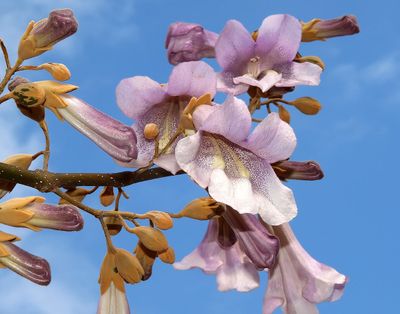Unfortunately, bamboo is just one of many in a mighty long list of invasives that plague gardeners. Another royal pain in the rump is the royal empress tree (Paulownia tomentosa), also known as princess tree or royal paulownia. While getting rid of this extremely fast-growing tree may seem like a never-ending battle, there may be some things you can do to stem the spread of paulownia. Read on to learn more about royal empress control.
The Spread of Paulownia
The royal empress tree, native to western China, was a prized flowering ornamental in Europe and introduced to the United States in the early 1800’s. It may have also infiltrated the United States via imports from China, who used the fluffy seeds of the royal empress as packing material. It’s easy to point fingers at whoever brought this into our country as an ornamental, but when you take in the beauty of the royal empress tree, can you really blame them? Heart-shaped leaves and clusters of around 2 inch (5 cm.) fragrant lavender flowers in the spring (sigh) can be oh so pretty– so very, very pretty. Wait…what’s happening? I drank in so much of the beauty that I need some sobering statistics. Reality check– this tree is invasive! We need to know how to kill paulownia trees because their rapid growth and spread is crowding out native plants, destroying our wildlife habitats, and threatening our timber and agricultural industries. You see those 21 million tiny winged seeds being dispersed through the wind? That’s just from ONE tree and those seeds germinate very easily in scant amounts of soil. The royal empress tree can also grow up to a staggering 15 feet (4.5 m.) in a single year! The height and width of a royal empress tree can peak at 80 and 48 feet (24 and 15 m.) respectively. Okay, so we know how it got here and how it spreads, but what about getting rid of royal empress?
Controlling Paulownia
Let’s find out how to kill paulownia trees. The most effective means of getting rid of royal empress is with the use of herbicides. Several options for royal empress control are presented below for different sized trees. The herbicides used should have one of the following active ingredients: glyphosate, tricopyr-amine, or imazapyr. The best time for herbicide treatments is generally summer and fall. Apply herbicides as directed on the product label. Note: Chemical control should only be used as a last resort, as organic approaches are safer and much more environmentally friendly.
Large Tree Options (trees over a head high):
Hack and Squirt. Utilized when tree removal is not an option. Use a hatchet to cut slits around the tree stem into the bark. Then, spray herbicide into the slits with a handheld spray bottle. The tree should die over the course of the growing season, but re-application may be necessary the following year when for controlling paulownia. Cut and Paint. Cut the tree down with a chainsaw. Then, with a backpack sprayer or handheld spray bottle, apply herbicide on the tree stump within a few hours of cutting.
Small Tree Options (trees under a head high):
Foliar Spray. Use a backpack sprayer with a cone nozzle to spray herbicide onto the tree leaves. Cut and Paint. Cut the tree down with a hand saw or chainsaw. Then, with a backpack sprayer or handheld spray bottle, apply herbicide on the tree stump within a few hours of cutting.
Young Seedlings or Sprouts:
Hand Pull. When hand pulling, be sure to capture the entire root system. Best done when the soil is moist. Foliar Spray. Apply a foliar herbicide if new shoots appear. Seeds: Bag and dispose of any seed capsules in a heavy garbage bag.
